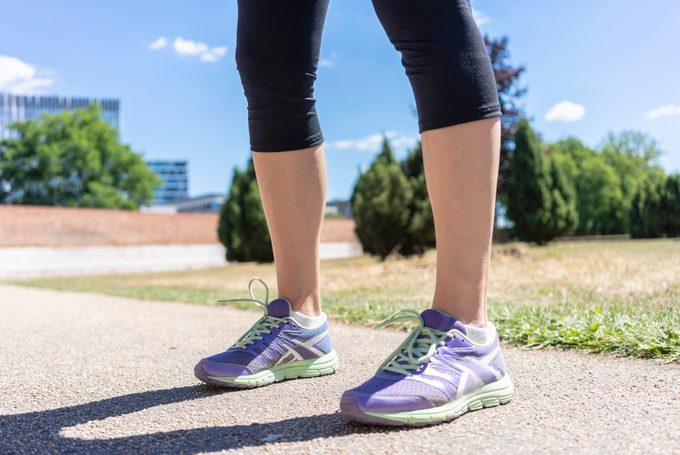Shin Splints: Why They Happen and How to Avoid Them
Do you experience pain in your shins when you’re running? How about when you go on long walks? You may have shin splints, a common injury seen in runners and even long-distance walkers. If the pain—which can feel like soreness, a dull ache, or sharp pain—continues even when you’re walking or not moving at all, you may have a more severe case. Here’s what you should know about shin splints, including how to recognize the symptoms, why they occur, how to treat them, and what you need to do to keep this overuse injury at bay.
What are shin splints?
Shin splints are a common injury for runners, both new and seasoned alike. They can also happen to dancers, long-distance walkers, and people who who have flat feet or exercise without proper foot support or in a high-impact way.
Basically shin splints occur because of repetitive activity that affects the muscle and bone tissue, causing inflammation in the lower leg, according to the American Academy of Orthopaedic Surgeons. This causes pain along the border of the tibia, also known as the shinbone. “It’s a tough injury that can sideline runners, or anyone involved in a sport or activity that involves a high degree of running,” explains Blake Dircksen, a physical therapist at Bespoke Treatments in New York City. “It’s painful, stubborn, and debilitating.”
Some other injuries that get lumped into the vague “shin splints” category are compartment syndrome, posterior tibialis tendonitis, flexor hallucis tendonitis, or strains of these muscles, explains Dircksen. “Medial tibial stress syndrome is the more accurate name for the sharp, bony pain felt right on that tibia bone, but it’s more commonly referred to as ‘shin splints,’ he explains. “And if you’ve been running for long enough, you’ll eventually experience it—maybe it’s a rite of passage!”

Signs and symptoms of shin splints
The telltale sign that you’re experiencing shin splints, or medial tibial stress syndrome, is if you experience sharp pain when you press directly on the medial side (closest to the middle of the body) of the tibia (shin) bone. “While you’re running, symptoms can vary, but generally it will hurt at the beginning of the run, maybe reduce in severity in the middle, and then be painful again at the end of the run,” says Dircksen. “Single-leg hopping on the affected side is usually painful, too.” If it’s bad enough, shin splits can even cause pain when you’re walking or not moving at all.
Dircksen explains that the pain symptoms due to shin splints exist on a continuum. “On one end of the spectrum, you can have inflammation of the tibia, or shin bone, and on the other end you have a full-blown fracture,” he says.
If you’re experiencing any of these symptoms, especially the more painful latter ones, you should consult with a doctor or physical therapist.
Causes of shin splints
There can be many factors that cause shin splints, but some of the biggest drivers are the following:
Improper training
If you’re training too often, with too much intensity, and too much volume, or your exercise increase is happening too quickly or without an adequate amount of recovery time, it can cause shin splints. “The bone tissue of the tibia is a dynamic, living tissue just like your muscle or tendon, that is capable of breaking down and building up or getting stronger,” explains Dircksen. “If your training involves too much volume or intensity over a short window of time, you’re at a higher risk of exceeding the bone’s capacity for tolerating that workload. Over time, and without adequate recovery, this imbalance of breakdown versus build up can lead to inflammation and swelling of the periosteum, or the outer layer of the bone, which tends to correlate with the experience of shin pain.”
Inadequate sleep
As you probably know, sleep is important for many reasons including the fact that when we sleep, our bodies repair and heal. The National Sleep Foundation recommends that adults get between seven and nine hours of sleep. But active individuals may need even more. “Without adequate rest, the body isn’t able to get into those deep, restorative sleep cycles, which impairs the body’s repair process,” explains Dircksen. (Not getting good zzz’s? Here are some tips from sleep doctors for better sleep.)
Training age
If you’re newer to the sport of running or sports that involve running in general, you’re more likely to be at risk for shin splints, explains Dircksen. People who participate in ball sports in childhood or adolescence are less likely to experience stress fractures later in life than those who do not, according to a 2015 study in PM&R, the official scientific journal of the American Academy of Physical Medicine and Rehabilitation. “Those that grew up playing a variety of sports, in addition to running, have likely developed favorable bone architecture and motor skills that are protective to shin splints,” says Dircksen.
A higher body mass index
A higher body mass index (BMI), which is a measure of weight in kilograms divided by height in meters squared, is linked to a greater risk of shin splints in active people, according to a 2016 study in the Journal of Athletic Training,

Diagnosing shin splints
Because the diagnosis of shin splints is largely based on a person’s history of pain, and acute pain when you put pressure on the medial side of your tibial bone, you can usually figure out if you have shin splints on your own. However, you should still see a healthcare professional if the pain persists or if you’re experiencing the same pain when you’re at rest.
“It’s important to get this diagnosis right, because this isn’t the sort of injury you want to train through, or else you’ll trend down that continuum towards more severe bony injury,” explains Dircksen. “With some injuries, working through pain is OK. With a bony stress injury like shin splints, there’s less room for negotiation, so a proper diagnosis is important.”
How to treat shin splints
The good news? You can treat shin splints on your own if you know what to do. Unfortunately, there isn’t one specific fix for the injury. But certain things like icing, stretching, and foam rolling may help with day-to-day symptoms, says Dircksen. “Chances are good though that the injury needs to be treated from a comprehensive view, with all training variables considered, and the running program must be modified,” he says. Here are some ways to treat shin splints:
Rest
“I don’t like to use the word rest, because it implies that the athlete is not doing any work, so let’s call it relative rest,” says Dircksen. “During a period of relative rest, the athlete may stop running, but they’re still working on other exercise strategies to maintain fitness. The goal of relative rest is to offload the injured area, in this case, the tibia, while building strength facilitating the repair process.”
One thing you don’t want to do? Take a period of complete rest, warns Dircksen. “Complete rest may help with symptoms in the short term, but when it comes time to start training again, the tissue is in a deconditioned state,” he says. “The deconditioned state makes the athlete more susceptible to further injury, and the pain cycle continues. ”
Modify training variables
“If you’re a runner, you know the terms ‘miles per week,’ ‘long run,’ ‘threshold run,’ ‘intervals,’ and so on,” says Dircksen. “We’ll need to look at bringing the overall workload down to calm down the irritation, while at the same time building up the tissues around the tibia.” Depending on the severity, cross training on the elliptical or bike, and even some days off, may be a necessary step, he suggests.
Strength and conditioning
Remember, every person is unique, which makes it tough to get an exact prescription for the cure—but you can’t go wrong getting stronger, says Dircksen.
“By strength training the calf complex and muscles of the lower extremity, you’re increasing the work capacity that those tissues are able to handle,” he explains. “When you get back to running, your workload tolerance will be higher, making you more resilient against injury.”
Mobility
Soft tissue mobility—including modalities like foam rolling, stretching, icing, and massage—can be helpful in creating a temporary change in muscle length, which will affect the ankle joint’s overall range of motion, explains Dircksen. “We also need to consider the mobility of the joint itself. Making sure that the bones of the ankle joint are moving, sliding, and gliding properly ensures a healthy range of motion,” he says. “A healthy joint is important in distributing the forces over the full joint range of motion like intended, rather than overusing a narrow range.”
How to know when shin splints have healed
Unlike some other injuries, when it comes to shin splints, once your symptoms have disappeared, your injury is likely gone. Being able to hop on one leg without pain is a good sign, too, explains Dircksen. “Going for a run and having no pain is a better sign,” he says. “And of course, don’t jump right back into training! You’ll need a calculated progressive approach so the injury doesn’t return.”

Preventing shin splints
Speaking of returning, here are some things Dircksen recommends to prevent this painful injury from coming back (or happening in the first place).
- Progress your training appropriately. Don’t do too much volume or intensity over too short of a window of time.
- Listen to your body. Fitness is built over time, not all at once. Stack a bunch of positive runs on top of each other.
- Eat appropriate food. Fueling your body for success will allow you to maintain your training.
- Sleep well. Allow yourself enough time to repair while you sleep.
- Do exercises other than running. Workout classes, cycling, cross training, and other sports offer a different challenge to the legs and help stave off overuse injury.
- Be as strong as possible. Strength training protects against overuse injury and improves performance.
If you’re a runner that’s battling shin splints and you want to keep running, Dircksen urges that you find a physical therapist who understands how to manage the injury effectively. “A restructuring of the athlete’s training schedule and loading program needs to be implemented as soon as possible to minimize time away from training and maintain consistency.”

No comments